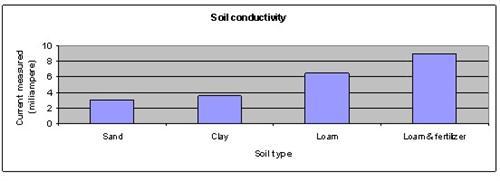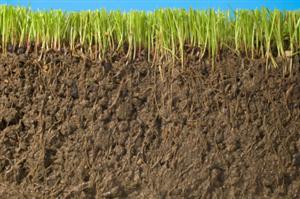| Complexity level: | 5 |
| Project cost ($): | 30 |
| Time required: | 6 hours for preparation, 1 hour to conduct this science project experiment |
| Material availability: | Easily found at a hobby store |
| Safety concerns: | None |
Hypothesis
The loam soil with fertilizer added will have the highest level of electrical conductivity.
Overview
Soil conductivity
Healthy soil normally contains salt and minerals required for plants to grow. As plants absorb nutrients from soil, nutrient level in soil will deplete unless replenished through the nutrient cycle or the addition of fertilizers.
Adding water to soil will dissolve the nutrients present and create an electrolyte solution in the soil. By planting 2 electrodes in the soil and applying the voltage across the terminals, the conductivity of the soil can be measured. This can be used as an indicator of soil fertility and the nutrient level of the soil. Fertile soil with high amounts of mineral compounds will have high conductivity while depleted soil with less minerals will have lower conductivity.
The electrical conductivity of the soil also depends on the type of mineral salts present. This is because some minerals are better at conducting electricity than others. For example, ammonium sulfate is two times more effective at conducting electricity than calcium nitrate, while urea will not conduct any electricity at all.
Scientific Terms
Materials
The materials required for this science fair project:
- 200g of sand
- 200g of clay
- 400g of loam
- 50ml of liquid fertilizer
- 800ml of water
- 4 beakers
- 1 DC12V battery
- 3 jumper wires with crocodile clips at both ends
- 2 copper electrodes
- 1 miliammeter
- 1 digital weighing scale
- 1 measuring cylinder
- 1 ruler
- 1 clock
Procedure
1. For this science fair project, the independent variable is the type of soil used – sand, clay, loam and loam mixed with fertilizer. The dependent variable is the conductivity of the soil. This is determined by measuring the current conducted in the soil using a miliammeter. The constants (control variables) are the amount of soil in the beaker, the amount of water added, the temperature of the environment (which will remain at room temperature), the battery voltage and the distance between the electrodes.
2. Dry the samples of sand, clay and loam under the sun or in an oven, to remove moisture.
3. Label the 4 beakers ‘sand’, ‘clay’, ‘loam’ and ‘loam with fertilizer’. Measure out 200g of each type of soil and place in the appropriate beaker, Then, measure and add 200ml of water into each beaker. Add 50ml of liquid fertilizer to the beaker marked ‘loam and fertilizer’.
4. Leave the beakers aside for 30 minutes. This will allow the soil to absorb the water, as well as allow the mineral salts to dilute.
5. Insert 2 copper electrodes 5 cm apart in one beaker. Connect the ammeter and the DC12V battery to the electrodes. Record the current measurement in a table, as shown below.
6. Repeat step 5 with the remaining beakers.

Results
The results show that loam mixed with fertilizer has the highest electrical conductivity, while sand exhibits the lowest conductivity.
| Soil type | Sand | Clay | Loam | Loam & fertilizer |
| Miliampere measured | 3 | 3.5 | 6.5 | 9 |
The graph below represents our results:

Conclusion
The hypothesis that loam soil with fertilizer added will have the highest electrical conductivity has been proven to be true.
The measurements of soil conductivity will only provide some hints as to the amount of minerals present in the soil. It cannot identify the types of minerals that are present. There are many types of conductivity meters available in the market today that are able to measure soil conductivity.
Also consider
The science fair project may be repeated by adding different types of minerals to the soil samples and subsequently comparing their electrical conductivity.
The experiment may also be modified to measure the effects of other factors on electrical conductivity, eg. by varying the amount of water added, the temperature of the environment, or the pH of the soil.
References
How to measure soil conductivity? - http://www.ehow.com/how_5901417_measure-soil-conductivity.html
From the soil up – conductivity - http://www.fromthesoilup.com.au/soil/conductivity
Testing the soil conductivity - http://www.eutechinst.com/techtips/tech-tips22.htm

